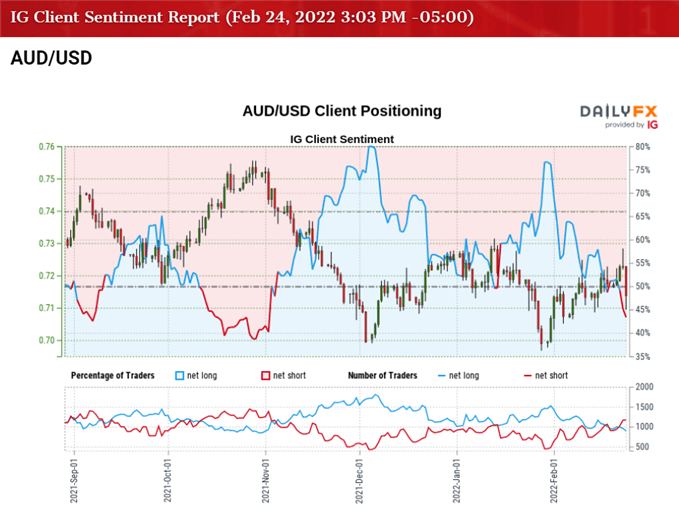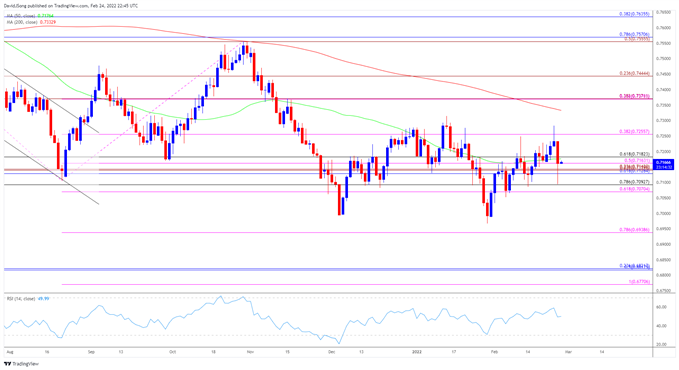Australian Dollar Talking Points
AUD/USD snaps the series of higher highs and lows form earlier this week as the heightening Russia-Ukraine tensions appear to be spurring a flight to safety, and the exchange rate may consolidate ahead of the next Reserve Bank of Australia (RBA) interest rate decision on March 1 as it fails to test the January high (0.7314).
AUD/USD Fails to Test January High Ahead of RBA Rate Decision
AUD/USD extends the decline from the monthly high (0.7284) as the Greenback appreciates against all of its major counterparts, and fresh data prints coming out of the US may keep the exchange rate under pressure as the Federal Reserve’s preferred gauge for inflation is expected to increase for the fifth consecutive month.

The update to the US Personal Consumption Expenditure (PCE) Price Index may influence AUD/USD as the core reading is expected to widen to 5.1% from 4.9% per annum in December, which would mark the highest reading since 1983, and another uptick may generate a bullish reaction in the US Dollar as evidence of persistent inflation puts pressure on the Federal Reserve to adjust its exit strategy.
As a result, AUD/USD may consolidate over the remainder of the month with the Federal Open Market Committee (FOMC) on track to implement higher interest rates in 2022, but the RBA rate decision may influence the near-term outlook for the exchange rate if the central bank adjusts the forward guidance for monetary policy.

A material change in the RBA’s language may prop up the Australian Dollar as the central bank acknowledges that “inflation had picked up more quickly than the Bank had expected,” and it remains to be seen if Governor Philip Lowe and Co. will prepare Australian households and businesses for a looming change in regime as the central bank pledges to “not increase the cash rate until actual inflation is sustainably within the 2 to 3 per cent target band.”
In turn, the RBA may stick to a wait-and-see approach as “the Board is prepared to be patient as it monitors how the various factors affecting inflation in Australia evolve,” and more of the same from the central bank may undermine the recent recovery in AUD/USD as market participants prepare for higher US interest rates.
Until then, AUD/USD may trade within a defined range as fails to test the January high (0.7314), but a further decline in the exchange rate may fuel the recent flip in retail sentiment like the behavior seen during the previous year.

The IG Client Sentiment report shows 57.92% of traders are currently net-long AUD/USD, with the ratio of traders long to short standing at 1.38 to 1.
The number of traders net-long is 16.38% higher than yesterday and 2.32% higher from last week, while the number of traders net-short is 39.95% lower than yesterday and 31.67% lower from last week. The rise in net-long interest had fueled the flip in retail sentiment as 51.55% of traders were net-long AUD/USD last week, while the decline in net-short position comes as the exchange rate quickly bounces back from a fresh weekly low (0.7095).
With that said, AUD/USD may face headwinds ahead of the next RBA rate decision as another uptick in the US PCE Price Index puts pressure on the FOMC to adjust its exit strategy, and the advance from the January low (0.6968) may turn out to be a correction in the broader trend as the exchange rate appears to be reversing ahead of the yearly high (0.7314).



AUD/USD Rate Daily Chart

Source: Trading View
- Keep in mind, AUD/USD cleared the November 2020 low (0.6991) earlier this year after failing to hold above the 50-Day SMA (0.7176), but lack of momentum to test the 0.6940 (78.6% expansion) region has pushed the exchange rate back above the moving average as the Relative Strength Index (RSI) diverged with price.
- AUD/USD appeared to be on track to test the January high (0.7314) as the exchange rate rallied to a fresh weekly high (0.7284), but lack of momentum to clear the yearly opening range has pulled the exchange rate back towards the Fibonacci overlap around 0.7130 (61.8% retracement) to 0.7180 (61.8% retracement), with a break/close below the 0.7070 (61.8% expansion) to 0.7090 (78.6% retracement) region bringing the February low (0.7033) on the radar.
- Failure to defend the January low (0.6968) opens up the 0.6940 (78.6% expansion) region, with the next area of interest coming in around 0.6770 (100% expansion) to 0.6820 (23.6% retracement).
- At the same time, lack of momentum to break/close below the 0.7070 (61.8% expansion) to 0.7090 (78.6% retracement) region may keep AUD/USD within a defined range, with a move above the 0.7260 (38.2% expansion) area bringing the January high (0.7314) back on the radar.



--- Written by David Song, Currency Strategist
Follow me on Twitter at @DavidJSong



